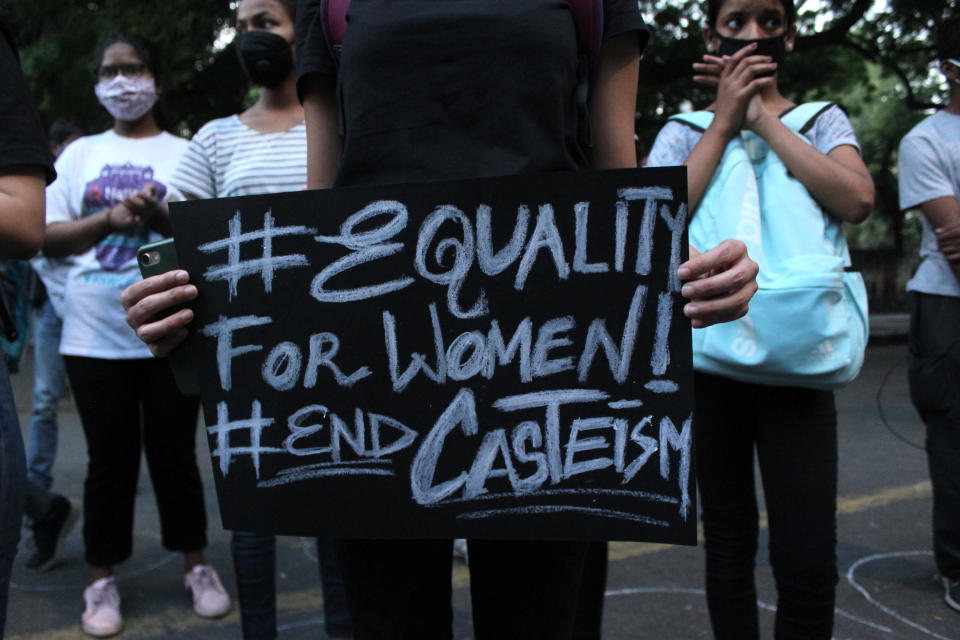No country for women. Dalit women, in particular

The centuries old caste system has been a trigger for heinous murders and violence all along, even after seven decades of it being officially abolished. The lowest in the caste rung, the Dalits or the untouchables, it goes without saying, are mainly at the receiving end.
But it’s their women who are the worst off. Because of their gender and caste, the Dalit women have been the hardest hit.
Subjected to unspeakable atrocities by upper caste people with brazen impunity, they are nothing but a tool to teach a lesson to their entire community and crush any form of dissent among them. Marginalized and helpless, they are an easy prey for all kinds of sexual predators on the prowl.
The gangrape and murder of a 19-year-old Dalit woman last month by four upper caste men in a village of Hathras district in UP (some 200 km from the nation’s capital) served as a chilling reminder of the fact. As a horror-struck nation learnt about the details of the bestial act and the apathetic attitude of the local police and authorities in the immediate aftermath, one thing became clear – the road to justice would be a long, arduous one.
Strangulated, backbone crushed, tongue chopped off and bleeding from her private parts, the victim was found in the field by her mother. When rushed to a hospital, treatment did not follow immediately. Only when her condition deteriorated substantially, was she taken to New Delhi for treatment. She died soon after.
The nightmare wasn’t over yet. Her body was brought back to the village and cremated by the local police at the dead of the night without her family allowed to do the last rites. It was then that the crime hit the headlines, all thanks to a journalist who had recorded everything finally brought it to the fore.
Subsequent media scrutiny, pressure from opposition parties and a rising tide of public anger over the tardy investigation (rape was even ruled out at some point) finally forced the state government to form a special investigation team.
And this wasn’t a one-off rare, unfortunate incident. Rather, it’s pretty common.
Close on the heels of the Hathras rape, in came the news of another gruesome gangrape and murder of a 22-year-old Dalit woman in the same state. Sent back home in an auto-rickshaw with a glucose drip inserted in her hand after being violated severely, she succumbed to the grievous injuries within hours.
In both the cases, given the extreme brutality that attracted media glare, the culprits have been arrested. But this is not always the case.
In another such recent gangrape of a Dalit woman in Madhya Pradesh, the police not just refused to file a FIR but went ahead and harassed the victim and her husband, eventually forcing the woman to commit suicide.
And this brings us to the saddest part: hundreds of such crimes against Dalit women going unreported and unredressed. It is said that four Dalit women get raped every day. Extreme penury and years of subjugation by the upper caste people make legal recourse out of bounds for most of them. Their perpetrators often roam about freely bullying them into silence. The law and order machinery is only meant to serve the powerful, who manipulate it to their advantage.
The Badaun gangrape and hangings of two lower caste teenaged girls in 2014, in UP’s hinterland again, is just an example of that. Massive press attention led to the case being assigned to the premier investigative agency of the nation, the CBI. A pawn in the hands of the then ruling party, it failed spectacularly. The CBI ruled out rape, harassed the victim’s family and tried to shift the blame on the hapless father stating it was a suicide. It turns out, the CBI field officers were all residents of villages situated near Katara where the crime happened.
The state machinery failed the victim. It was shameful and worrisome at the same time. You couldn’t even trust the highest investigative agency to conduct an impartial investigation! Under these circumstances, what hope is there for the doomed Dalit women to ever taste justice in this nation and lead a dignified life?
Disclaimer: The views expressed in this article are the personal opinions of the author and do not reflect the views of Yahoo India. Yahoo India does not assume any responsibility or liability for the same.

 Yahoo Finance
Yahoo Finance 